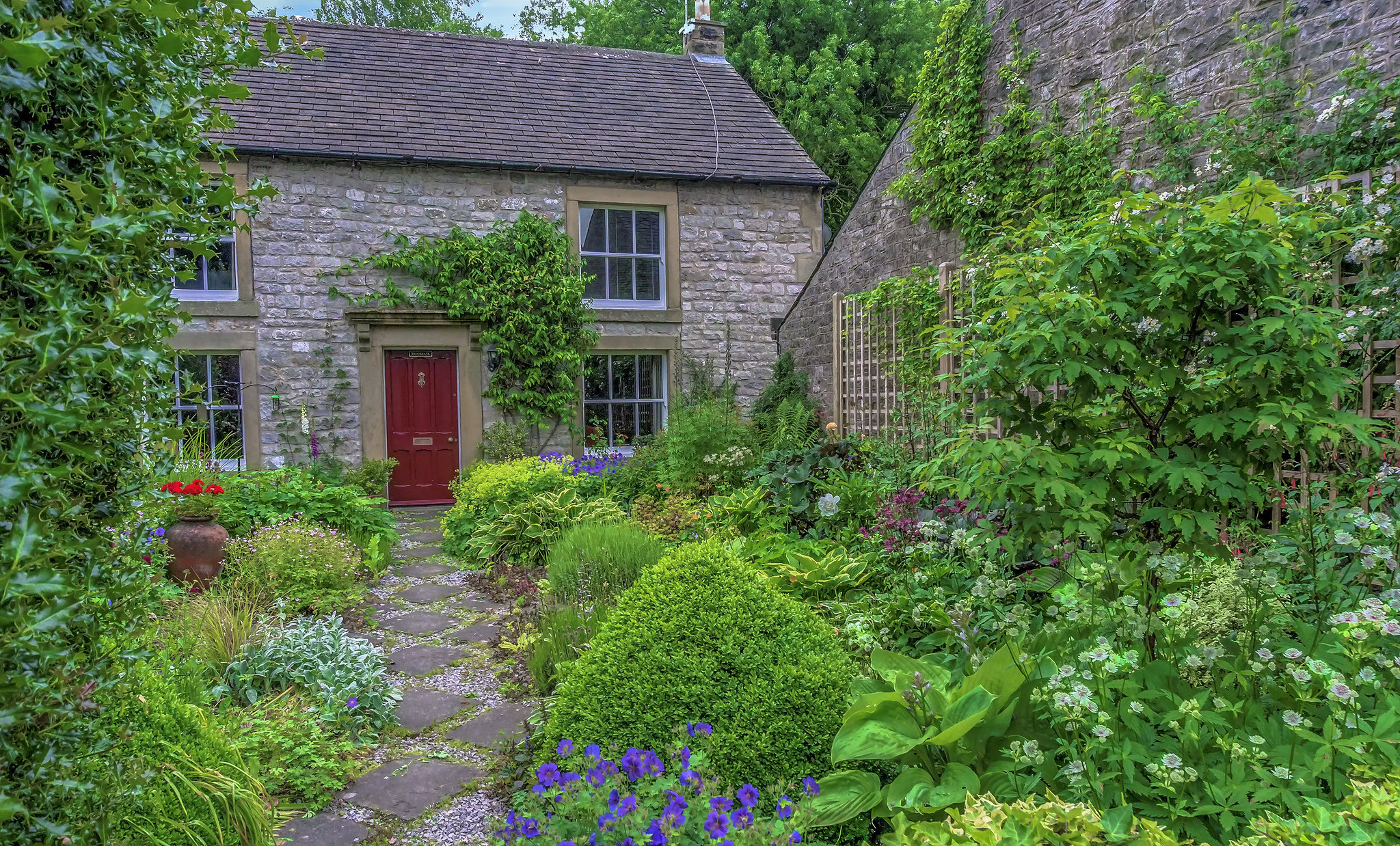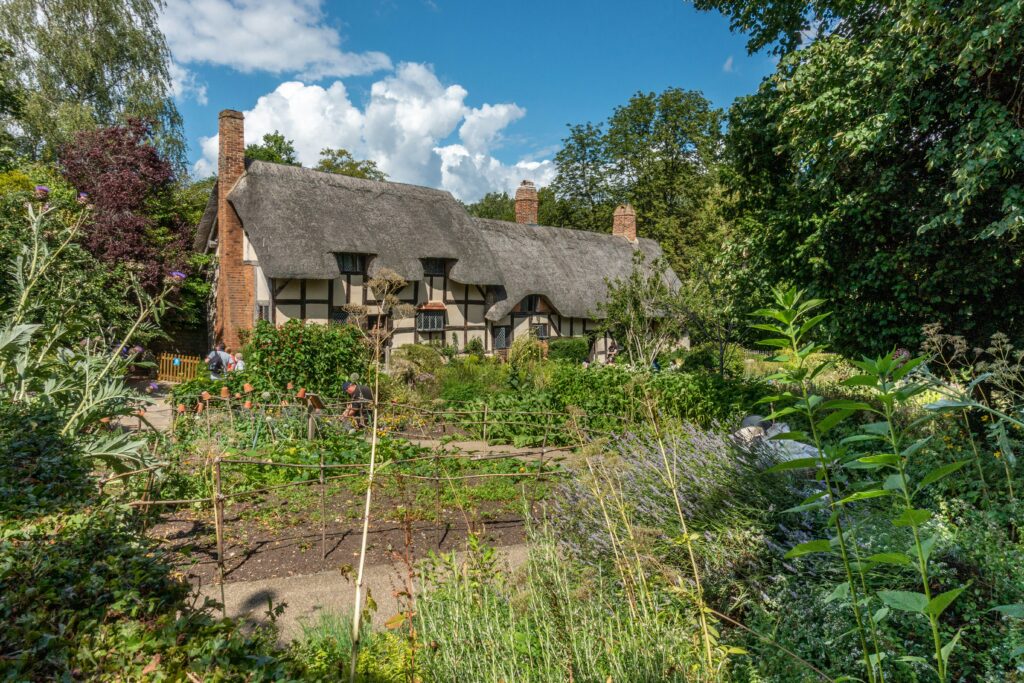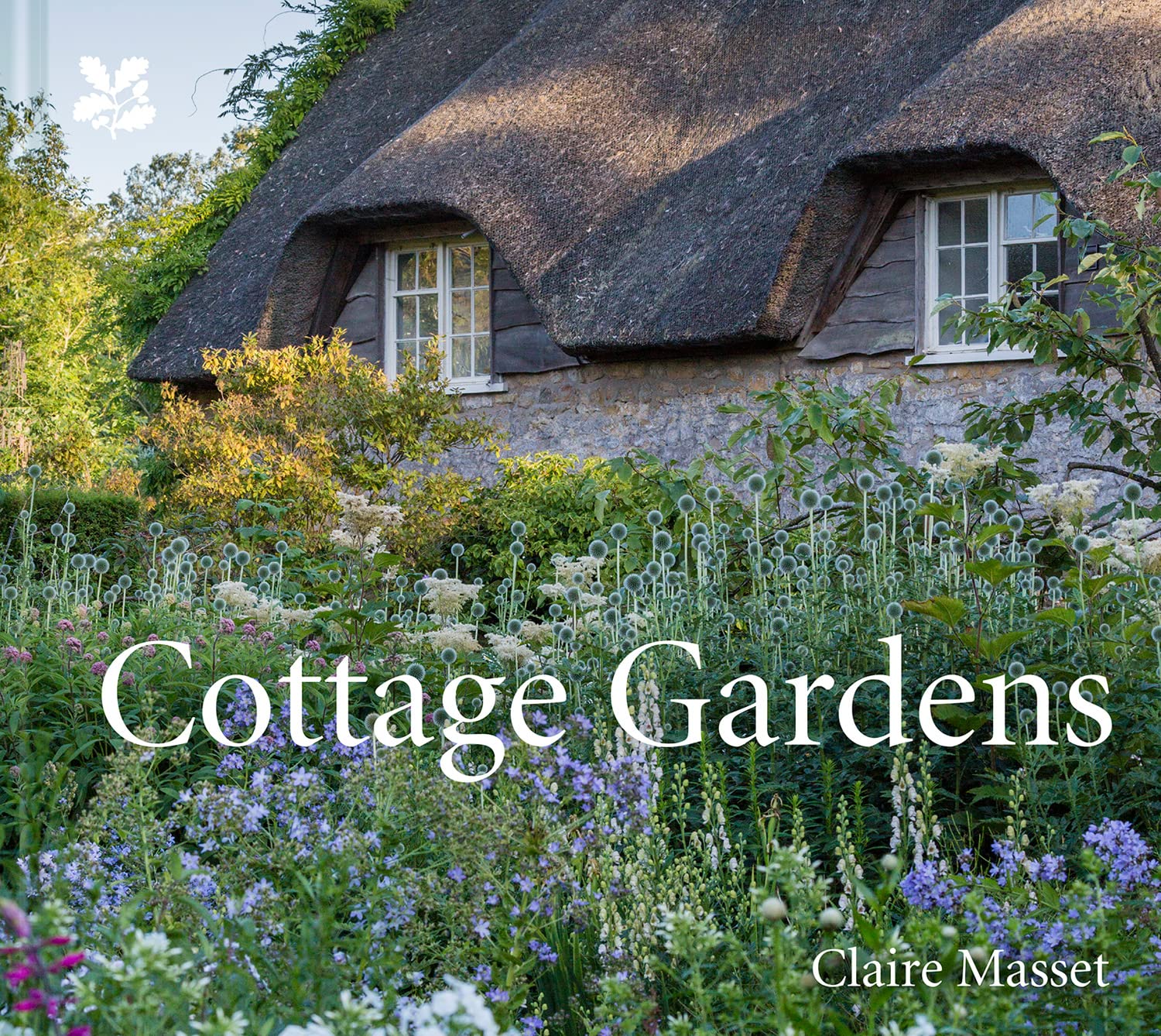A Beginning Gardener’s Guide To Cottage Gardens

There are few garden styles more beloved than a traditional English cottage garden. In this article, we’ll discuss the origins of the cottage garden style, describe some of the main elements, and discuss how you can duplicate the cozy, romantic style of the traditional cottage garden whether you live in the rainy English Cotswolds or the dry deserts of Arizona.
A Brief History of Cottage Gardens

Traditional English cottage gardens have their origins in the kitchen gardens of medieval peasants. These gardens were typically small and enclosed with fences to keep livestock such as pigs, chickens, and honeybees. They were used to grow vegetables, fruits, and herbs to diversify the family’s diet. Because of their small size, every available inch of space was needed to grow something useful, so these gardens were primarily utilitarian, not aesthetic. However, some flowers would be grown to make medicines or dyes, and to feed the bees.
Starting in the Tudor era, more flowers began to be incorporated into these practical gardens for aesthetic purposes, and this accelerated in the Victorian era, when the rise of the middle classes allowed more people to garden for pleasure instead of survival. The cottage garden style has remained enduringly popular ever since.
Perhaps the most famous Victorian cottage garden of all was Beatrix Potter’s garden at Hill Top, which she used as a setting in many of her books:
Elements of Traditional Cottage Gardens
Traditional cottage gardens were intended to meet the needs of the gardener first and foremost, and the style today remains flexible and loosely defined, with some modern cottage gardens incorporating mostly edible and medicinal plants to nourish the family that lives there, and others containing mostly flowers chosen for their aesthetics rather than their function. Most cottage gardeners end up with a mix of both.
As a result, there are not really any firm rules for gardeners wishing to create a cottage garden. However, here are some of the common elements most associated with the style:
- Cottage gardens are diverse and full of life. Traditional cottage gardens incorporated dozens of different species of vegetables, flowers, herbs, fruits, shrubs, vines, and trees, all packed into a small space that seemed to overflow with color, fragrance, and abundant food. The profusion of flowers also attracted pollinators and other beneficial and not-so-beneficial insects, which in turn attracted birds and other wildlife, supporting biodiversity in the surrounding community.
- Cottage gardens are informal. Cottage gardens rarely have the straight lines and square corners that characterized more formal garden styles in England and elsewhere. They instead use primarily natural curved borders and paths. Plantings should convey a sense of riotous and somewhat free-spirited abundance, due to the widespread use of self-sowing annuals and other naturally spreading plants that may pop up in unexpected places at times. However, this does not mean that they are chaotic, unplanned, or untended.
- Cottage gardens are hardy and low-input. Traditional English cottage gardens used primarily low maintenance native plants that grew vigorously in the English countryside without additional irrigation or protection from the elements. Though the exact species may vary depending on climate and other garden conditions, vigorous and low maintenance plants such as hardy perennials and self-sowing annuals remain the preferred plants for this style.
- Cottage gardens use both horizontal and vertical space. Because traditional cottage gardens needed to produce as much food, forage, and medicine as possible in a small space, cottage gardeners used climbing plants such as sweet peas, pole beans, squash, roses, honeysuckle, and wisteria on walls, fences, pergolas, and other vertical structures to maximize the use of space.
- Cottage gardens use mostly or entirely natural materials. Fences, pathways, arbors, and other garden structures in the classic cottage garden are usually made of natural materials such as wood, stone, and ceramics.
With climbing roses, bright hollyhocks, pathways edged with honeysuckle, blossom-filled orchards, and wildflower meadows, this is the perfect book to capture the idyllic British country garden and a wonderful companion for all cottage-garden enthusiasts.
Classic Cottage Garden Plants





Image credits: Elisa Way, Kim Sung Jin, Mark James, Colin Maynard, Michelle Tresemer
Because of the utilitarian origins of the cottage garden, most of the flowers associated with this style are easy to grow and multipurpose. They usually include a mix of hardy perennials and self-sowing annuals and biennials. In addition to looking beautiful, most traditional cottage garden flowers have culinary or medicinal uses, can be used to make dyes or household crafts, provide forage for poultry and livestock, and/or attract pollinators and other beneficial insects.
Examples of common traditional cottage garden flowers include:
- roses
- foxglove
- delphinium
- hollyhocks
- daffodil
- peony
- phlox
- violet
- hydrangea
- daisies
- dianthus
- columbine
- hardy geranium
- clematis
- cosmos
- zinnia
- dahlia
- lily
- tulip
- poppy
- and many more!
Traditional cottage gardens would also have incorporated vegetables, fruits, and edible and medicinal herbs such as:
- potatoes
- onions
- mint
- lavender
- peas
- thyme
- sage
- strawberry
- cherry
- cabbages
- apple
- pear
- plum
- turnips
- and many more!
These edible additions to the cottage garden became less common as the style became more ornamental. However, many modern cottage gardeners are now beginning to incorporate them back in to the style as edible landscaping, which is intended to be beautiful as well as productive, has returned to popularity.
Because traditional cottage gardens were often quite small, the cottage garden style adapts beautifully even to very small spaces such as patios and balconies. Most popular cottage garden flowers, vegetables, fruits, and herbs grow well in containers, which can be clumped and grouped together to create an exuberant effect just like a cottage garden grown in the ground!
Adapting the Cottage Garden Style To Other Climates
The classic English cottage garden is undeniably beautiful, but what if you love the cottage garden style, but don’t live in England? Even worse, what if you live in a place with a climate and native flora that is nothing like England’s?
Don’t worry, you can still create a beautiful cottage-style garden using plants that will grow better in your local region!
For example, many wildflowers native to Eastern North America and the prairie regions fit beautifully into a cottage-style garden. Examples include:
- purple coneflower
- black-eyed Susan
- wild bergamot/bee balm
- Joe Pye weed
- pasque flower
- yarrow
- butterflyweed
- New England aster
- cardinal flower
- jerusalem artichoke
- blazing star
- and many more!




Image Credits: Alissa Kennedy, Damiev Campbell, Ember Navarro, Jeffrey Hamilton
It is even possible to have a colorful and abundant cottage-style garden in regions with climates as un-English as possible, such as the deserts of the US Southwest. It simply requires adjusting your palette of plants.
For example, some heat and drought tolerant plants that can help you fill your desert garden with colorful, long-lasting blooms and unique foliage include:
- salvia
- penstemon
- California poppy
- blanketflower
- sedum
- agave
- rosemary
- Indian paintbrush
- ocotillo
- evening primrose
- brittlebush
- and many more!




Image credits: Vijayalakshmi Nidugondi, Erol Ahmed, James Jeon, Mickey Dziwulski
Here are some resources with inspiration and ideas for cottage gardening in the Western United States and other arid regions:
- Your Guide to Growing an English Cottage Garden in the West
- How to Grow Cottagecore Charm in the Desert
- Defining the New American Cottage Garden
Wherever you live, a cottage-style garden can add a touch of romance and whimsy to your yard and fill your life with blooms and biodiversity.
Featured image credit: Peter

0 Comments